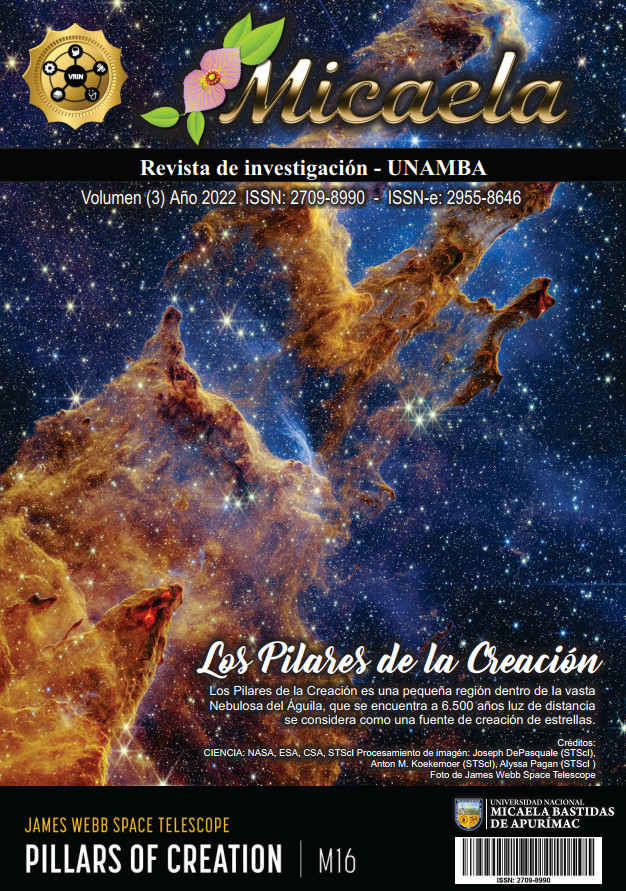Efficient microorganisms in the production of purple corn (Zea mays L)
Main Article Content
Abstract
The study analyzes the effect of three levels of efficient microorganisms (EM) on the yield of grain and cob of purple corn (Zea mays L.), which was carried out at the INIA Donoso agrarian experimental station, in Huaral, Lima, Peru in the agricultural period 2019-2020. Three treatments were applied: T1= 01 Lt. ME, T2= 03 Lt. ME, T3= 06 Lt. ME and one control 00 Lt. ME, with four replicates in a completely randomized block experimental design (DBCA). The results conclude that the doses of EM applied to the purple corn variety PMV 581, have a significant effect (p-value < 0.05) on the grain yield with values for the control of 3.54 ± 0.77 MT/Ha, with increases in the ( T1) at 5.05 ± 0.54 TM/Ha, in (T2), with 5.64 ± 0.33 TM/Ha and (T3) with 6.53 ± 0.77 TM/Ha. In the results of production of cob it is similar, achieving results for the (control) 1.09± 0.24 TM/Ha, increasing in (T1) 1.26± 0.27 TM/Ha, in (T2) 1.45± 0.28 TM/Ha and the (T3) with 1.74± 0.30 MT/Ha. and it is concluded that there is an effect on the yield of grain and purple corn cob, resulting in (T3)=06Lt EM, achieving a better average yield in grains and purple corn cob, compared to the control treatment.
Article Details

This work is licensed under a Creative Commons Attribution-NonCommercial-ShareAlike 4.0 International License.
Los nombres y las direcciones de correo electrónico introducidos en esta revista se usarán exclusivamente para los fines establecidos en ella y no se proporcionarán a terceros o para su uso con otros fines.
How to Cite
References
E. Ñaupari Alcoser, Evaluación de diferentes dosis de microorganismos eficientes (ME) en cultivo de Zea mays L.(Maíz amarillo duro) en la zona de Satipo., Satipo, 2015., Satipo, 2015.
León, El efecto de biol más microorganismos eficientes (EM) sobre el comportamiento agronómico del maíz (Zea mayz l.) (Bachelor's thesis, Quevedo-UTEQ)., Quevedo, 2015.
Quillca Delgado y Rubelo Cardenas, Efecto de microorganismos efectivos en el rendimiento del cultivo de maiz (Zea mays l.) asociado al trebol (Medicago hispida), en condiciones de secado., 2012.
Cruz, Investigación Empírica: Características, Métodos y Criterios https://www.lifeder.com/investigacion-empirica/, 2018.
G. y. Llallahui, «Abonamiento orgánico y microorganismos eficientes en la absorción de fósforo por maíz morado (Zea mays L.) - Ayacucho,» Revista Investigación, vol. 26, nº 1, pp. 11-16, 2018.
https://doi.org/10.51440/unsch.revistainvestigacion.2018.1.52
Peñafiel, Evaluación de diferentes dosis de microorganismos eficientes (me) en el cultivo de pepino (cucumis sativus) híbrido atar ha-435 (Bachelor's thesis)., 2005.
Begazo, Marco De Siembra En El Rendimiento De Maiz Morado (Zea Mays L.)“Ecotipo Arequipeño” En La Irrigacion Majes 2012-2013., Majes, 2013.
Cabrera, Tres láminas de riego en el rendimiento de cuatro variedades de maíz morado (Zea mays L.) bajo riego por goteo., 2016.
Carhuapoma y Lopéz, Maíz Morado moléculas bioactivas antioxidantes y anticancerigenas. CONCYTEC. Editorial de la Universidad Nacional Mayor de San Marcos. Primera Edición. Lima. Perú., Lima, 2008.
INIA, Manejo Agronómico Del Maíz Morado En Los Valles Interandinos el Perú. La Molina – Lima., Lima, 2012.
Justiniano, Fenología e intensidad de color en corontas del maíz morado (Zea mays l.) en sus diferentes estados de desarrollo en la localidad de La Molina., Lima, 2010.






